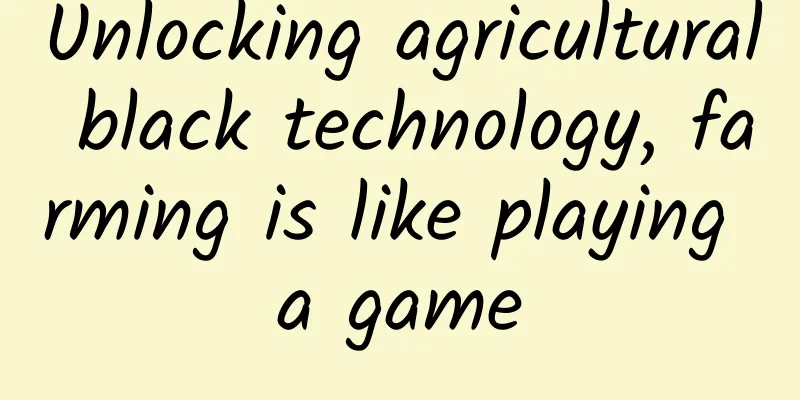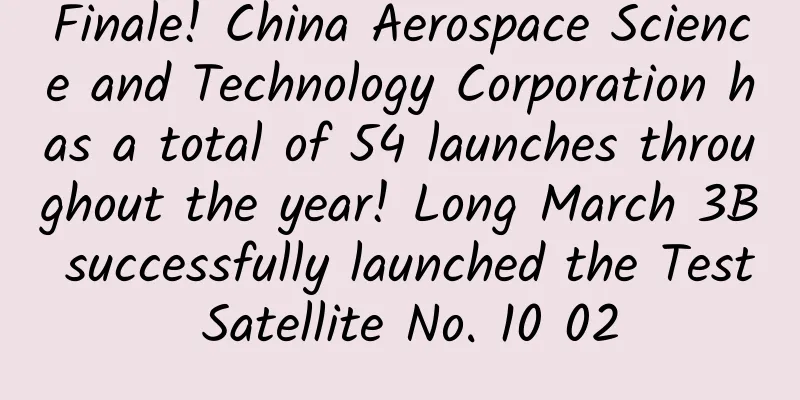Unlocking agricultural black technology, farming is like playing a game

|
In my country's long agricultural civilization, many poems describing labor have emerged, such as "hoeing the field at noon, sweat dripping down the field", "feet steaming with the hot earth, back burning with the scorching sun", "no idle people in the farming month, all family members work on the fields", etc. These poems formed our initial impression of agricultural labor. Rural life and labor methods are always primitive, hard and monotonous. Nowadays, agricultural labor has long been updated and evolved into a new look in places we cannot see, "online watering", "one-click pest control", "only hearing the sound of machines, no seeing people running around"... Riding on the east wind of scientific and technological development, modern agriculture has become cool without knowing it. Agriculture is equipped with technology From traditional slash-and-burn agriculture to modern agriculture with the roar of machinery, the process is inseparable from the update and iteration of science and technology. Modern agriculture in the intelligent era integrates the Internet, cloud computing, and Internet of Things technologies, relying on various sensors and wireless communication networks deployed in agricultural production to enable the agricultural production environment to have intelligent perception, intelligent decision-making, and expert online guidance. Specifically, modern agriculture mainly relies on the following key technologies: Internet of Things technology. If you want to manage farmland without leaving home, you need to be able to grasp all farm information at any time, and this requires the Internet of Things and big data platforms. The Internet of Things connects the environmental conditions in the real farm to the network, exchanges and communicates information through information dissemination media to form big data, and realizes intelligent identification, positioning, tracking, supervision, etc. All data including soil conditions, meteorological environment, etc. are on the screen, and you can "have it all" with just a click of the mouse. Smart sensors. The data of smart farms comes from smart sensors distributed throughout the farm. The information they collect mainly includes basic environmental parameters that affect crop growth, such as light intensity, CO2 concentration, air temperature and humidity, etc.; data information on crop growth itself, such as leaf temperature and humidity, stem and fruit related parameters, etc.; related parameters of environmental control equipment, such as equipment start and stop time, power, energy consumption, etc. Smart sensors process and summarize the collected data and upload them to the agricultural intelligent information management system to form real-time big data. Smart agricultural machinery. Unlike traditional agricultural machinery, smart agricultural machinery is equipped with a variety of sensors, remote monitoring and satellite positioning equipment, which can record the operation time, harvest volume, movement trajectory and other data of the harvester. Through the mobile terminal, the specific location, operation status, and operation area of each agricultural machinery are all clear at a glance. With unmanned remote operation, spring plowing and autumn harvesting can be handed over to the "machine butler". The correct way to open "farming" In modern farms, everything from sowing to fertilizing, spraying and harvesting is done with the help of technology. What will it look like? In 2021, XAG set up a "super cotton field" test base in Xinjiang cotton fields, where two young people managed 3,000 acres of cotton fields to see how technology can help agricultural development. The process of farming crops is mainly divided into four steps: tillage, planting, management and harvesting. Among them, the three links of "tillage, planting and harvesting" can be almost completely mechanized through intelligent agricultural machinery. The most time-consuming and energy-consuming part is the "management" of crops. In the past, 3,000 acres of land required at least 20 long-term workers, who patrolled the fields every day to observe the growth of cotton, diseases, watering or weeding... Now, this part of the work can finally be done online. One of the most labor-intensive processes in cotton fields is watering. The traditional management method is drip irrigation plus manually controlled valves. It is a huge task to go through a large cotton field and open and close the valves. But now the valves are replaced with automatic valves and remotely controlled. In the past, people had to go to the fields to water the fields manually, but now they only need to click on the APP on the iPad to water the fields accurately. The screen in front of them shows how much water should be poured on each field and where the water should seep into. A large number of plant protection drones are used to spray pesticides in Xinjiang cotton fields. Through big data and machine learning, drones are able to identify insect pests. For example, if a drone finds an area with a wrong spectrum while patrolling a cotton field, it can mark the location on a map and then transmit high-definition images to the cloud for remote diagnosis. Then, according to the condition of the disease, the plant protection drone can be equipped with pesticides for targeted removal. Farming has bid farewell to "facing the earth and back to the sky". The new way of farming is to get up every day, turn on the computer or mobile phone to check the data to see whether the data indicators are normal, and then decide whether it is necessary to go to the site to check. From "living by the weather" to "farming by looking at the screen", technology is making it all possible. Bringing more possibilities to agriculture According to the spirit of the "Central Document No. 1" in 2021, developing smart agriculture and establishing an agricultural and rural big data system is the general direction of agricultural development in the future. Digital agriculture is not only reflected in the technological content of the planting process, but also in the intelligence of the entire process from "planting to marketing". In the future, agriculture will use big data to analyze market demand and achieve production based on demand; use intelligent analysis and management in the specific planting process; and automatically grade agricultural products according to their size, weight, appearance, and quality through digital sorting. Finally, we will cooperate with e-commerce platforms to establish intelligent logistics parks, open up the production and marketing chain, and realize the full intelligence of the entire process from planting to marketing. Technology serves the people's livelihood, and artificial intelligence, the cutting-edge technology of the 21st century, will be the best assistant for agricultural activities. Artificial intelligence is best at replacing repetitive human labor, and agriculture is an excellent experimental field. In the future, the technology of "artificial intelligence + drones + unmanned vehicles" will become the most important part of promoting agricultural reform. From backward production models to big data-driven market orientation and mechanized operations, digitalization is reshaping the new pattern of rural development. In the future, scientific papers will be written not only in the vast space, but also on the vast land. References [1] Han Mingyue. Design of Internet of Things Automatic Control System for Smart Agriculture[D]. Harbin Institute of Technology, 2016. [2] Mao Guanjun. Chongming creates the first "5G+smart agricultural machinery" demonstration application scenario in China[J]. Contemporary Agricultural Machinery, 2020, {4}(01):11. [3] Wang Lijiao. Smart agriculture empowers high-quality development: A record of smart agriculture development at Beidahuang Group’s Qixing Farm[J]. China Agricultural Reclamation, 2021, {4}(06): 29-31. This article is produced by the Science Popularization China-Creation Cultivation Program. Please indicate the source when reprinting |
<<: Is brewing tea in a thermos cup toxic and carcinogenic? What food safety experts say
>>: Another mysterious "aliens" has visited Earth! It's visible to the naked eye!
Recommend
Airbnb’s Growth Case Study
Airbnb, Chinese name:爱Airbnb , is a service websi...
How to increase followers on Tik Tok? Is there any good way to become popular on Tik Tok? Is it useful to like?
Nowadays, more and more young people like to play...
Super cool! 10 km vertical take-off and landing return flight, my country's reusable rocket has made a new breakthrough!
At noon on September 11, China's independentl...
From radicalism to ending and then chasing: the manned moon landing war between China, the United States and Russia
In the past two years, the most obvious feeling i...
Tmall Magic Box 2nd Generation 1S Review: A Smart TV Box That Adds Color to Your Life
Faced with the current booming smart TV industry, ...
Brand marketing: the first step to brand success!
Schopenhauer said that one of the most special we...
Who says wild boars can’t eat fine bran? They don’t really want it!
If ordinary people are told that "wild boars...
The mRNA of the new coronavirus vaccine can be reverse transcribed into DNA. Are genetically modified humans coming?
Recently, the latest research from a Swedish univ...
Curiosity made a major discovery: the lakes on Mars were once frozen due to the cold, and there is also a carbon cycle!
[Mobile software: Bo Ke Yuan] By studying the che...
"People infected with COVID-19 have long-term abnormal lung function"? A secret to debunk this rumor
If you interpret the paper carefully, you will fi...
App promotion tips: in-depth analysis of how to direct traffic to the app?
Introduction: Generating traffic and users is not...
Google and Apple's strategic race: updating the system to "manage everything"
In the early morning of June 26, Google held its ...
What kind of weird fruit is this? I didn’t expect that the core can be eaten!
It is the heaviest fruit in the world. Although i...
What do new media users really like? Here’s a new trend report!
"What do users like to watch?" has beco...
How can you become a marketing expert without talent?
When you are engaged in marketing- related work, ...









